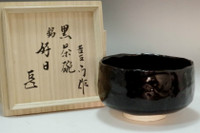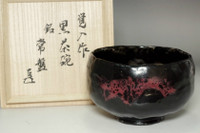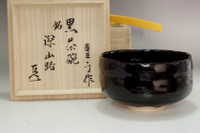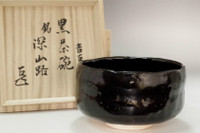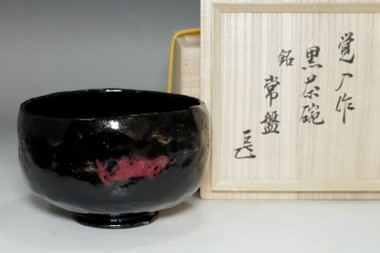 Loading... Please wait...
Loading... Please wait...Currency Displayed in
- Home
- SOLD ITEMS
- Raku 14th Kakunyu 'kuro raku chawan' black glazed tea bowl #4212
Categories
Raku 14th Kakunyu 'kuro raku chawan' black glazed tea bowl #4212 for sale
Product Description
Up for sale is this "Raku 14th Kakunyu 'kuro raku chawan' black glazed tea bowl #4212" If you have any questions please contact us before buy it. No reserve.
- width: approx. 12.7cm (5in)
- height: approx. 8cm (3 5⁄32in)
- weight: 278g (gross 504g)
writing on the box: Kichizaemon made a black tea bowl, name of the tea bowl is Tokoiwa, which means a rock that is always the same. In turn, to be perpetual.
1918-1980
Born as the eldest son of thirteenth generation Raku master Seinyu, his birth name was Yoshihisa but was later changed to Sokichi. He graduated from the Tokyo Fine Arts School (now Tokyo University of the Arts) with a degree in sculpture in 1940. Afterwards, he returned to his home province, and with his father having already passed away the year prior, he inherited the mantle of Kichizaemon at the age of 28. Upon returning home, Kakunyu had to reestablish the Raku family and begin making pottery literally on his own. It was after 1955 that Kakunyu is thought to have really begun to display his own unique style.
In 1959, he produced one of his masterpieces, the black Raku tea bowl “Rinsho” Following this, he began exhibiting and gaining acclaim for his modern and figurative pieces, beginning with a dual exhibition with Eiraku Zengoro (Sokuzen) in 1964. This was followed by his first solo exhibition in 1973 and, among others, a trio exhibition titled “Ichi-raku Ni-hagi San-karatsu” with Miwa Kyuwa, 13th Miwa Kyusetsu – living national treasure in Hagi ware, and Nakazato Muan, 12th Nakazato Tarouemon – living national treasure in Karatsu ware, in 1975. In 1976, with the goal of preserving and popularizing Raku ware, he donated all of the works and materials passed down through the generations of the Raku family and began making preparations for the establishment of the Raku Museum. Following two years of construction, the Raku Museum opened in 1978, and in the same year was recognized by the Agency for Cultural Affairs as the holder of an intangible cultural property for which records ought to be preserved. However, due to years of fatigue and overwork both physically and mentally, Kakunyu suffered a heart attack in 1976 and passed away from lung cancer in 1980 at the age of 63.
Kakunyu began his pottery career after the end of World War II and studied sculpture at the Tokyo Fine Arts School, where he cultivated an understanding and consciousness of the creation of three-dimensional form and the figurative power of sculpture. Using what he learned there as his fuel, he ushered in a new era in Raku ware pottery. Kakunyu said it himself: “Tradition does not imply imitation. One must live in his own time and build his own world.” For him, the key was not to simply imitate a style, or copy or revive something. The key was to leave proof of the era of one’s birth, and to take that unique consciousness born from the “now” in which one lived and throw it into one’s work. His shaping by means of a spatula tool, a technique also used in sculpture, firmly and constructively captured the frame of his tea bowls. Particularly, a modern artificiality is seen in many of his red tea bowls. His two-toned bowls created with various glazes and a contemporary sensibility, color transformations and speckles achieved by playing with the heat of the kiln, and his vistas of kiln-induced color change were all new forms of Raku ware that hadn’t previously existed. This was not just limited to his bowls, as modernistic pieces can also be seen among his other tea utensils. His notable works include: the black Raku tea bowl “Rinsho”; the black Raku flat tea bowl “Shiosai”; the red Raku tea bowls “Juei,” “Sugikodachi,” and “Aki no Yamaji”; and a green-glazed water jar in the shape of a turban shell.
shop policy
AppraisalWe are a very small team with limited resources and are unable to conduct scientific age verification or appraisals by the artist’s descendants. We evaluate items using specialized reference books, scholarly resources, and knowledge inherited from senior experts in the field. If a purchased item does not meet your expectations, please feel free to contact us. We sincerely value your opinion.
Cancellation and Return
We accept return only if you contact us within 30 days after you receive the items. Return-shipping costs are the buyer’s responsibility. If you ask a cancellation before shipping the package, we may ask a 20% restocking fee.
Shipping
+ Shipping to the USA, Europe, and Asia is free. For other areas, please contact us. Shipping is via EMS or DHL.
+ VAT is not included in the item price.
+ We will ship within 3 business days. Shipping time is usually around a week.
Insurance
We are not responsible for delays, returns, damage or loss due to customs or postal processing. EMS is insured (the amount on the label is the guaranteed amount). If you choose DHL, we recommend that you purchase additional insurance. Please note that if you choose the DHL drop service option, insurance will not be applied.
Taxes
Import duties, taxes and fees are not included in the item price. If your country requires customs duties, etc., it is your responsibility to pay them.
To customers buying tableware
Our products are mostly used. We sell them in the same condition they were purchased, please be sure to clean them thoroughly before actually using them.



